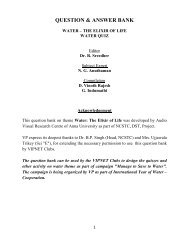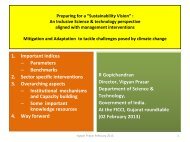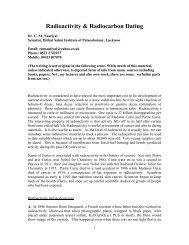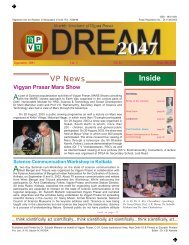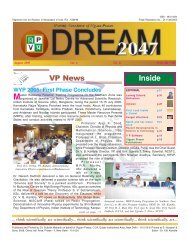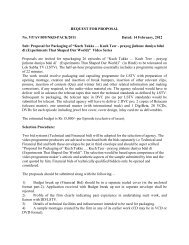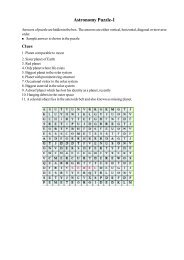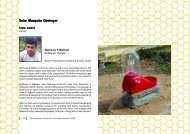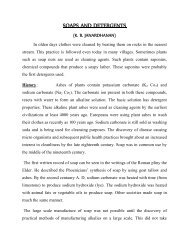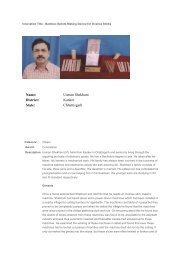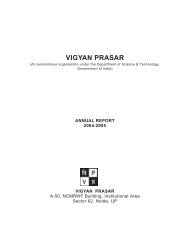vipnet news - Vigyan Prasar
vipnet news - Vigyan Prasar
vipnet news - Vigyan Prasar
Create successful ePaper yourself
Turn your PDF publications into a flip-book with our unique Google optimized e-Paper software.
VIPNET NEWS<br />
A A monthly monthly <strong>news</strong>letter <strong>news</strong>letter of of <strong>Vigyan</strong> <strong>Vigyan</strong> <strong>Prasar</strong> <strong>Prasar</strong> Network Network of of Science Science Clubs Clubs - VIPNET - VIPNET<br />
NOVEMBER 2012 VOL. 10 NO. 11 PRICE: j2.00<br />
National<br />
Mathematical<br />
Year 2012<br />
Inside<br />
fo'ks"k fo'ks"k fo'ks"k ys[k<br />
ys[k<br />
fVdkÅ fVdkÅ fVdkÅ ÅtkZ ÅtkZ lHkh lHkh ds<br />
ds<br />
fy,&varjjk"Vªh; fy,&varjjk"Vªh; o"kZ&2012 o"kZ&2012<br />
o"kZ&2012<br />
Paul Erdos: The Man<br />
Who Loved Only<br />
Numbers<br />
gj gj Hkw[ks Hkw[ks dks dks feysxh feysxh jksVh jksVh<br />
jksVh<br />
Photo Quiz<br />
Puzzle<br />
Club Speak<br />
Registered with the Registrar of Newspapers of India: R.N. DELENG/2002/8668<br />
fVdkÅ fVdkÅ fVdkÅ ÅtkZ ÅtkZ ÅtkZ lHkh lHkh lHkh ds ds ds fy,<br />
fy,<br />
fy,<br />
varjkZ"Vªh; varjkZ"Vªh; varjkZ"Vªh; o"kZ&2012<br />
o"kZ&2012<br />
o"kZ&2012<br />
fiz; fiz; fiz; foiusV foiusV lnL;ksa]<br />
lnL;ksa]<br />
bl lky jk"Vªh; cky foKku Økaxzsl dk eq[; fo"k; ^ÅtkZ lEHkkouk,a mi;ksx vkSj laj{k.k* gSA ;g fo"k;<br />
vxys lky Hkh tkjh jgsxkA jk"Vªh; cky foKku Økaxzsl dk fo"k; blfy, vkSj Hkh izklafxd gS fd vkt<br />
Hkh fodkl'khy ns'kksa ds djhc rhu vjc yksx [kkuk idkus ,oa vU; dk;ks± ds fy, ijaijkxr ÅtkZ lalkèkuksa<br />
ij fuHkZj gSaA ;g nqHkkZX; gS fd vkt Hkh Ms
jk"Vªh; jk"Vªh; jk"Vªh; xf.krh; xf.krh; o"kZ o"kZ 2012<br />
2012<br />
gekjs nSfud thou ,oa ns'k<br />
dh vkfFkZd izxfr ds fy,<br />
^ÅtkZ* dh ,d egRoiw.kZ<br />
Hkwfedk gSA fdlh Hkh lekt esa<br />
izfr O;fDr ÅtkZ dh [kir<br />
mlds thou ;kiu dh xq.koÙkk<br />
n'kkZrh gSA vkfFkZd izxfr ,oa<br />
ÅtkZ&mi;ksx vkil esa lh/ks<br />
tqM+s gq, gSaA D;ksafd mRiknu<br />
ds lk/kuksa dks pykus ds fy,<br />
ÅtkZ dh t#jr iM+rh gSA vxj xq.koÙkkiw.kZ ÅtkZ dh miyC/krk gS rks ns'k<br />
dh oSKkfud ,oa rduhdh izxfr Hkh vkxs c
National Mathematical Year 2012<br />
� eksVjxkM+h ls fudys /kq,asa dk ekuo LokLF; ij izHkkoA<br />
� FkeZy ikoj IykaV ds vif'k"V ty ds }kjk tyh; thoksa dk iznw"k.kA<br />
� ikoj&ykbUl ds dkj.k tkuojksa dh e`R;qA<br />
� rst jks'kuh ds pkjksa vksj iraxksa dk teko rFkk mudk Hkkstu djus okys<br />
thoksa dk teko&budh la[;k ij izHkkoA<br />
� ok;q&ÅtkZ mRiknu l;a=k dk] fpfM+;ksa ,oa nwljs tkuojksa ij izHkkoA<br />
� [knku {ks=k ds vkl&ikl lYQj ,oa /kwy d.kksa dk izHkkoA<br />
� bZaV&HkV~Bs ds }kjk ÅtkZ mi;ksx&tyku&ydM+h dk mi;ksx ,oa bldk<br />
izHkkoA<br />
� Ñf"k {ks=k esa ÅtkZ mi;ksx rFkk i;kZoj.kh; izHkkoA<br />
� Ñf"k gsrq tehu rS;kj djus] Qly dkVus] nwljs LFkku ij tkus rFkk<br />
izlaLdj.k esa ÅtkZ dk mi;ksx rFkk oSdfYid rjhds fudkyukA<br />
� [kk| inkFkksZa dh ÅtkZ&n{krk] ÅtkZ mi;ksx ,oa ÅtkZ iSnk djus ds<br />
lanHkZ esaA<br />
� cSVjh vif'k"V dk izHkko&[kkldj dspqavk ;k vU; lq{e thoksa ijA<br />
� Bksl&vif'k"V&buds }kjk ÅtkZ mRiknu dh izfØ;k dk i;kZoj.kh;<br />
izHkkoA<br />
5- 5- ÅtkZ ÅtkZ izca/ku izca/ku ,oa ,oa ,oa laj{k.k<br />
laj{k.k<br />
� fo|ky;@laLFkku] gkLihVy@?kj dk ÅtkZ&vads{k.kA<br />
� gfjr&Hkou dh ÅtkZ&iz.kkyh le>ukA<br />
� vkink izca/ku esa uohdj.kh; ÅtkZ dh HkwfedkA<br />
� fo|ky; dk ty&vads{k.k@dSaVhu dk vads{k.kA<br />
� fo|ky; ;k ?kj esa inkFkksZa dk iqupZØhdj.kA<br />
� xzkeh.k ikfjokfjd x`g esa ÅtkZ laj{k.kA<br />
� lkSj ÅtkZ ¼gfjr x`g½ dk ÅtkZ ys[kk&tks[kkA<br />
� bZaV HkV~Bk] vkVk pDdh@crZu cukus okys@yksgs ds lkeku cukus okys<br />
laLFkkuksa dk ÅtkZ vkadyuA<br />
� ÅtkZ mi;ksx dk fyax ifjn Hk;@izfr#iA<br />
� ÅtkZ [kir@mi;ksx ds ifjorZu dk ekuo thou&'kSyh ,oa lekt ij<br />
izHkkoA<br />
� LoLF; thou ds fy, ÅtkZA<br />
� ekuoh; vk/kkjHkwr t#jrksa ds fy, ÅtkZ rFkk thou&lqj{kkA<br />
� jlksbZ esa ck;ks ÅtkZ lzksr dk n{k mi;ksxA<br />
� Hkkstu&iz.kkyh dk ÅtkZ izfr#iA<br />
� R;ksgkjksa ds volj ij ÅtkZ mi;ksx esa cnyko&lekt ij bldk<br />
izHkkoA<br />
� Ñf"k {ks=k esa cnyrs rjhdksa ds dkj.k ÅtkZ mi;ksx esa cnykoA<br />
� fofHkUu lkekftd {ks=kksa esa lkeqnkf;d dsUnzks ds }kjk ÅtkZ dh cprA<br />
� LFkkuh; Lrj ij fofHkUu ?kjsyw mRikn cukus ls ÅtkZ laj{k.k dh<br />
lEHkkoukA<br />
� diM+k /kksus esa ^okf'kax e'khu* ls fd;s tkus okys dk;ksZa ,oa ekuoh;<br />
ÅtkZ ls fd;s tkus okys dk;ksZa esa [kir ÅtkZ dk rqyukRed vè;;u<br />
rFkk i;kZoj.kh; izHkkoksa ds vkdyuA<br />
6- 6- ÅtkZ ÅtkZ dh dh ;kstuk ;kstuk ,oa ,oa ,oa ekWMsfyax<br />
ekWMsfyax<br />
National<br />
Mathematical<br />
Year 2012<br />
20oha 20oha cky cky foKku foKku foKku dkaxzsl&2012<br />
dkaxzsl&2012<br />
vf/kd vf/kd tkudkjh tkudkjh ds ds fy, fy, ÑI;k ÑI;k ÑI;k lEidZ lEidZ djsa djsa %&<br />
%&<br />
MkW- MkW- ch-ih- ch-ih- flag flag<br />
flag<br />
oSKkfud oSKkfud ^th* ^th* ,oa ,oa izeq[k&jk"Vªh; izeq[k&jk"Vªh; foKku foKku foKku izkS|ksfxdh izkS|ksfxdh lapkj lapkj lapkj ifj"kn<br />
ifj"kn<br />
MkW- MkW- MkW- Mh-ds- Mh-ds- ik.Ms;<br />
ik.Ms;<br />
oSKkfud oSKkfud ^bZ* ^bZ* ^bZ* jk"Vªh; jk"Vªh; foKku foKku izkS|ksfxdh izkS|ksfxdh lapkj lapkj ifj"kn<br />
ifj"kn<br />
jk"Vªh; jk"Vªh; dk;ZØe dk;ZØe leUo;d] leUo;d] jk"Vªh; jk"Vªh; foKku foKku izkS|ksfxdh izkS|ksfxdh lapkj lapkj ifj"kn<br />
ifj"kn<br />
jk"Vªh; jk"Vªh; jk"Vªh; foKku foKku izkS|ksfxdh izkS|ksfxdh lapkj lapkj ifj"kn ifj"kn ifj"kn ¼jkfoizkSlai½ ¼jkfoizkSlai½<br />
¼jkfoizkSlai½<br />
foKku foKku ,oa ,oa izkS|ksfxdh izkS|ksfxdh izkS|ksfxdh foHkkx foHkkx foHkkx ¼Mh,lVh½<br />
¼Mh,lVh½<br />
rduhdh rduhdh Hkou] Hkou] u;k u;k egjkSyh egjkSyh jksM] jksM] ubZ ubZ fnYyh&110 fnYyh&110 016<br />
016<br />
bZesy bZesy % dkp@nic.in ; Telephone No. 011-26535564/26590251<br />
izks- izks- ,l-ih- ,l-ih- oekZ<br />
oekZ<br />
ps;jilZu] ps;jilZu] jkfoizkSlai&usVodZ<br />
jkfoizkSlai&usVodZ<br />
eksckby&09835247590<br />
eksckby&09835247590<br />
bZesy bZesy % % verma1946@gmail.com<br />
Jh Jh Jh vkj-,l- vkj-,l- j?kqoa'kh<br />
j?kqoa'kh<br />
lkekU; lkekU; lkekU; lfpo] lfpo] jkfoizkSlai&usVodZ<br />
jkfoizkSlai&usVodZ<br />
eksckby eksckby eksckby & & 09868404002 09868404002<br />
09868404002<br />
jkfoizkSlai&usVodZ<br />
jkfoizkSlai&usVodZ<br />
bZ&56] bZ&56] izFke izFke ry] ry] ry] leliqj leliqj jksM] jksM] jksM] ikaMo ikaMo uxj] uxj] fnYyh&110 fnYyh&110 fnYyh&110 091 091<br />
091<br />
Qksu Qksu %& %& %& 011&22799236<br />
011&22799236<br />
bZesy bZesy % % ncstcnet@hotmail.com<br />
ncstcnetwork@gmail.com<br />
� lw{e Lrjh; ÅtkZ ;kstuk ,oa ekWMsfyax&vius fo|ky; ls 'kq# djsaA<br />
� de ÅtkZ&[kpZ okys Hkou dh ;kstukA<br />
� vif'k"B ty ds iqupZØhdj.k dh ekWMfyax&fdlh dkWyksuh ;k lkslk;Vh<br />
{ks=kA<br />
� ifjogu {ks=k dh ÅtkZ ;kstuk@ifCyd&ifjogu ,oa futh ifjogu dk<br />
rqyukRed vè;;uA<br />
� vkt dk ÅtkZ mi;ksx&Lrj rFkk Hkfo"; dh t#jrksa dk vkdyuA<br />
� ÅtkZ ds egÙke mi;ksx gsrq f[kM+fd;ksa dk ekWMyA<br />
� n{k ÅtkZ mi;ksx gsrq ?kj@vkWfQl ds vanj dh ekWMfyaxA<br />
� Hkkstu cukus dh n{krk&iw.kZ iz.kkyh dh ekWMfyaxA<br />
� ÅtkZ&vkRefuHkZj xzke@fo|ky;@{ks=k dh ekWMfyaxA<br />
� fo'ofo|ky; ifjlj gsrq ifjogu iz.kkyh dh ekWMfyax&¼fofHkUu ÅtkZ<br />
ds lfEeJ.k ds lkFk½ A<br />
� fdlh xkao ds fy, lkSj ÅtkZ vkèkkfjr ty&iEi dh ekWMfyaxA<br />
� xzkeh.k lkeqnkf;d Hkou dh Nr dh ekWMfyax&ftlesa xeZ ty rFkk<br />
fo|qr ÅtkZ dh izkfIr gks ldsA<br />
� fo|ky; dh xfrfof/k≤ dh ;kstuk cukuk& ftlesa ÅtkZ dh t#jrs<br />
de dh tk ldsA �<br />
lzksr lzksr %<br />
%<br />
^20 20 20oha 20 oha us'kuy us'kuy fpYMuZ fpYMuZ lkbal lkbal lkbal dkaxzsl* dkaxzsl* lwpuk lwpuk izi=k<br />
izi=k<br />
VIPNET NEWS November 2012 / Vol. 10 / No. 11<br />
3
jk"Vªh; jk"Vªh; xf.krh; xf.krh; o"kZ o"kZ 2012 2012<br />
2012<br />
Paul Erdos<br />
The Man Who Loved Only Numbers<br />
Paul Erdos was a legend in his lifetime for various<br />
reasons. He was the most prolific mathematician of<br />
the 20th century, and was truly a pure<br />
mathematician. He was a problem solver. Problems<br />
were an essential part of his mathematical life.<br />
Throughout his life he posed and<br />
solved mathematical problems, not<br />
ordinary ones but the most difficult<br />
ones. For Erdos, a proof of a<br />
mathematical problem was not just<br />
a complicated sequence of steps. He<br />
believed that a proof of a problem<br />
must provide insight into why the<br />
result was true. Erdos epitomized<br />
the wit of the mathematical world.<br />
He was called a prince of problem<br />
posers. He encouraged other<br />
mathematicians to solve difficult<br />
mathematical problems. He believed<br />
that “mathematical truths are<br />
discovered and not invented.”<br />
Erdos was often called Euler (referring to the<br />
great 18th century German mathematician Leonhard<br />
Euler) of his times. He devoted his life to<br />
mathematics to an unequalled degree. Though he<br />
worked in many areas of mathematics, it was in<br />
number theory in which he excelled. He published a<br />
total of over 1,500 papers, .publishing one paper a<br />
week even in his seventies. Erdos liked to quote<br />
one of his colleague’s remarks, viz., “A<br />
mathematician is a device for turning coffee into<br />
theorems.” He spent his life working up to 20 hours<br />
a day on mathematical problems, usually with<br />
National<br />
Mathematical<br />
Year 2012<br />
“Problems have always been an essential part of my mathematical life. A well-chosen problem can<br />
isolate an essential difficulty in a particular area, serving as benchmark against which progress in this<br />
area can be measured. An innocent looking problem often gives no hint as to its true nature. It might<br />
be a ‘marshmallow’, serving as tasty tidbit supplying a few moments of fleeting enjoyment. Or it might<br />
be like an ‘acorn’ requiring deep and subtle insights from which a mighty oak can develop.”<br />
Paul Erdos<br />
“In our century, in which mathematics is strongly dominated by ‘theory constructors’ he has remained<br />
the prince of problem solvers and absolute monarch of problem poser….In many ways Paul Erdos is<br />
the Euler of our times. Just as the special problems that Euler solved pointed the way to analytic and<br />
algebraic number theory, topology, combinatorics, function spaces, etc., so the methods and results<br />
of Erdos’s work already let us see the outlines of great new disciplines, such as combinatorial and<br />
probabilistic number theory, combinatorial geometry, probabilistic and transfinite combinatorics and<br />
graph theory, as well as many more yet to arise from his ideas.”<br />
Ernst Strauss, who worked with both Albert Einstein and Paul Erdos<br />
Paul Erdos<br />
colleagues.<br />
Erdos’s first significant contribution to number<br />
theory was his elegant proof for the theorem which<br />
stated that ‘for each number greater than 1, there<br />
is always at least one prime number between it and<br />
its double.’ He proved this theorem<br />
when he was 21 years old. The<br />
theorem which was first conjectured<br />
by Bertrand in 1845 was earlier<br />
proved by the Russian mathematician<br />
Chebyshev in 1850 but Erdos’s<br />
proof was more elegant and<br />
elementary. His greatest achievement<br />
was the first elegant and elementary<br />
proof of the Prime Number Theorem,<br />
which was conjectured in the 18th<br />
century and had explained the pattern<br />
of prime numbers since 1896. The<br />
theorem had been earlier proved by<br />
Hadamard and de la Valee Poussin<br />
independently in 1896 by using<br />
complex analysis. Erdos developed his proof in<br />
1949. The Norwegian mathematician A Selberg also<br />
developed a proof independently of Erdos in the<br />
same year.<br />
Erdos did not have a permanent residence. He<br />
did not care for worldly success or personal<br />
comforts. To him any kind of property was a<br />
nuisance. He once said: “I never wanted material<br />
possessions. There is an old Greek saying that the<br />
wise man has nothing he cannot carry in his hands.<br />
If you have something beautiful, you have to look<br />
out for it, so I would rather give it away. I always<br />
VIPNET NEWS 4<br />
November 2012 / Vol. 10 / No. 11
National Mathematical Year 2012<br />
say, ‘Private property is a nuisance.’ He did not<br />
keep his earnings as lecturing fees or prizes for<br />
himself. He spent his earnings mostly by giving<br />
prizes to those who solved difficult problems in<br />
mathematics posed by him. The prizes fixed by him<br />
for solving problems ranged from<br />
25 US dollars (for a problem<br />
which he did not consider very<br />
difficult) to 10,000 dollars (for a<br />
problem in number theorem which<br />
he considered hopeless). The<br />
maximum amount that he paid as<br />
prize money for solving a problem<br />
was 1000 dollars. He also<br />
donated to students. Occasionally<br />
he also gave away his earnings<br />
to charities. In 1983 he won the<br />
most lucrative award for<br />
mathematicians, the Wolf Prize,<br />
with a prize money of 50,000 US<br />
dollars. He kept only 750 dollars<br />
for himself, the rest he gave<br />
away. He donated 30,000 dollars to a university<br />
mathematics department for the establishment of a<br />
memorial fund in the name of his mother. Most of<br />
the rest of the prize money he gave to his relatives<br />
for various reasons. He led a very simple life and he<br />
needed very little money to meet his requirements.<br />
He did not marry. Erdos was hardly interested in<br />
any kind of relationship ‘which was not founded in<br />
shared intellectual curiosity’.<br />
Erdos refused to accept a permanent job because<br />
he thought a permanent job would limit his ability<br />
to focus on mathematical problems and to collaborate<br />
with mathematicians in distant lands. For his work<br />
in pure mathematics, he did not require any<br />
equipment, or laboratory or library. He stayed with<br />
friends or at conferences. He practically lived out of<br />
a suitcase and travelled from one mathematical centre<br />
to another. In fact he died while attending a<br />
conference in Warsaw. He travelled extensively.<br />
There was a saying in circulation among his coworkers<br />
and friends: “If you want to meet Erdos,<br />
stay where you are and wait; he will appear there<br />
soon.” He was affiliated with the Mathematical<br />
Institute of the Hungarian Academy with the<br />
condition that he would receive his salary when he<br />
was in Hungary. He mostly lived on lecture fees,<br />
prizes and hospitality of collaborators.<br />
Paul Erdos was born on 26 March 1913 in<br />
Budapest, Hungary. Both his parents, Lajos and<br />
Anna Erdos were mathematics teachers. His parents<br />
were of Jewish origin but they did not observe the<br />
Jewish religion. He was one of three children of his<br />
Leonhard Euler<br />
National<br />
Mathematical<br />
Year 2012<br />
parents. His two sisters, both of whom died young<br />
of scarlet fever, were considered even brighter than<br />
Erdos. Erdos himself was a truly child prodigy. At<br />
the age of three he could multiply three digit numbers<br />
in his head. He also discovered negative numbers<br />
for himself at the age of three,<br />
when he subtracted 250 degrees<br />
from 100 degrees and came up<br />
with 150 degrees below zero.<br />
Erdos was a much protected child.<br />
His parents were very protective<br />
of him because they had lost two<br />
of their daughters and Erdos was<br />
the only remaining child. Someone<br />
said: “Erdos had never buttered<br />
his own toast till he was 21 years<br />
old.” He was taken out of school<br />
just after a few years. He was<br />
taught at home by his parents and<br />
a German governess.<br />
Erdos obtained his PhD degree<br />
in 1934 from the Peter Pazmany<br />
Catholic University in Budapest. After his doing his<br />
doctorate he went to Manchester in the UK as a<br />
Post Doctoral Fellow. He was in Manchester for<br />
four years. He used to visit Budapest at least three<br />
times a year during his stay at Manchester.<br />
However, with the rise of Hitler in Germany,<br />
Hungary was not a safe place for people of Jewish<br />
origin. He went to work at Princeton, USA. His<br />
initial fellowship was for a year. It was not extended<br />
because Erdos did not conform to Princeton’s<br />
standards. The authorities of Princeton found him<br />
“uncouth and unconventional”.<br />
In 1943, Erdos accepted a part-time appointment<br />
at Purdue University in USA. He was totally cut off<br />
from his family members and friends in Hungary<br />
during the war. In August 1945, he got <strong>news</strong> of<br />
his family. His father had died of a heart attack in<br />
1942. Somehow his mother and a cousin had<br />
survived. Four of his uncles and aunts were<br />
murdered. He could finally return to Hungary towards<br />
the end of 1948 to meet the surviving family<br />
members and friends. Before accepting a temporary<br />
appointment at the University of Notre Dame in<br />
USA in 1952, he travelled frequently between<br />
England and the USA. His terms of appointment<br />
were quite liberal. He was free to go anywhere in<br />
the world to do joint research work. He could have<br />
got his appointment on a permanent basis under<br />
the same liberal terms and conditions, but he did<br />
not want that way. In 1951, Erdos won the Cole<br />
Prize of the American Mathematical Society for his<br />
significant contributions to the number theory.<br />
VIPNET NEWS November 2012 / Vol. 10 / No. 11<br />
5
jk"Vªh; jk"Vªh; jk"Vªh; xf.krh; xf.krh; o"kZ o"kZ 2012<br />
2012<br />
In 1955, while applying for a post of permanent<br />
visiting professor, Erdos described himself in the<br />
following paragraph. “I Paul Erdos was born on<br />
March 26, 1913. I studied at the University of<br />
Budapest, I got my PhD at the University of<br />
Budapest in 1934. From 1934 to 1938 I had a<br />
research fellowship at the University of Manchester.<br />
I got the degree of DSc at<br />
Manchester in 1939 (in absentia).<br />
From 1938 to 1948 I was at<br />
various American universities,<br />
including the Institute for<br />
Advanced Study, University of<br />
Pennsylvania, Purdue University,<br />
University of Michigan, Stanford<br />
University, and University of<br />
Syracuse. In 1948- 49 I gave<br />
lectures at various universities in<br />
Holland, England and Hungary. In<br />
1949-50 I lectured at various<br />
American universities and in<br />
1950-51 I was at the University<br />
of Aberdeen in Scotland and<br />
1951-52 I was at University<br />
College of London. (In) 1952-53<br />
I was at the American University in Washington<br />
and was connected with the Bureau of Standards<br />
and the Institute of Numerical Analysis at Los<br />
Angeles. In 1953-54 I was visiting professor at the<br />
University of Notre Dame. I was supposed to be<br />
visiting lecturer there this year but was prevented<br />
to return there by circumstances beyond my control.<br />
I am supposed to be visiting lecturer at the American<br />
Mathematical Society in 1955-56 but it is not yet<br />
certain I will be able to take up the appointment.”<br />
He wrote by hand and there are some grammatical<br />
oddities in the paragraph.<br />
In 1954, he went to Amsterdam to attend a<br />
conference but on his way back he was interrogated<br />
by immigrant officials on his views on communism.<br />
In a response to a question what he thought of<br />
Marx he is supposed have replied: “I’m not<br />
competent to judge, but no doubt he was a great<br />
man.” He was denied re-entry visa. The interrogation<br />
was not the only reason for denying him re-entry<br />
visa. Other reasons have been cited for the US<br />
Government’s refusal to issue Erdos a re-entry visa.<br />
He had corresponded with a Chinese mathematician<br />
residing in USA but who had subsequently went<br />
back to China. Earlier, in 1941, Erdos earned an<br />
FBI record for no real fault of his. Erdos and two<br />
fellow mathematicians were rounded up by police<br />
near a military radio transmitter on Long Island.<br />
They landed up there because being absorbed in<br />
Srinivasa Ramanujan<br />
National<br />
Mathematical<br />
Year 2012<br />
animated discussion on mathematical subject they<br />
failed to notice the “No Trespassing” sign.<br />
Most of the ten years following the US<br />
Government’s refusal to grant him a re-entry visa,<br />
Erdos spent in Israel. In the early 1960s he made<br />
several request to the US authorities for a re-entry<br />
visa and eventually he was allowed<br />
back into USA.<br />
Erdos collaborated with about<br />
500 mathematicians. For a<br />
mathematician of Erdos’ time, it<br />
was considered an honour to<br />
collaborate with him. The<br />
American mathematician Casper<br />
Goffman introduced a concept<br />
called “Erdos number” around<br />
1965 as a symbolic<br />
demonstration of this honour.<br />
The Hungarian mathematician<br />
József Pelikán wrote: “Erdos<br />
undoubtedly had the greatest<br />
number of coauthors among all<br />
the mathematicians of all times –<br />
the number of his co-authors<br />
totalled about 500. It is not by chance that the<br />
mathematicians of the worlds introduced the concept<br />
of the “Erdos Number”. Someone has Erdos number<br />
1 if he/she has written common paper with Erdos,<br />
someone having a common paper with someone<br />
who has Erdos number 1 (but not with Erdos<br />
himself) has Erdos number 2, etc. A huge number<br />
of today’s mathematicians have a very small Erdos<br />
number. Erdos himself sometimes jokingly mentioned<br />
functional Erdos numbers: someone having n<br />
common papers with himself has Erdos number 1/<br />
n. Two mathematicians (A. Hanjal and A. Srkzy)<br />
have Erdos number less than 1/50 and the number<br />
of people having Erdos number less than 1/10 is<br />
close to 30.”<br />
Erdos himself valued collaboration with other<br />
mathematicians. Commenting on his work with the<br />
Polish mathematician Mark Kac he said: “This<br />
collaboration is a good example to show that two<br />
brains can be better than one, since neither of us<br />
could have done the work alone.”<br />
He maintained regular correspondence with his<br />
collaborators. He wrote about 1,500 letters every<br />
year. One of his collaborators, Dr. Joel H. Spencer<br />
of the New York University’s Courant Institute of<br />
Mathematical Sciences said: “He was always<br />
searching for mathematical truths…Erdos had an<br />
ability to inspire. He would take people who already<br />
had talent and had had some success, and just take<br />
VIPNET NEWS 6<br />
November 2012 / Vol. 10 / No. 11
National Mathematical Year 2012<br />
them to an entirely new level. His world of<br />
mathematics became the world we all entered.”<br />
Erdos was greatly influenced by the work of the<br />
great Indian mathematician Srinivasa Ramanujan. He<br />
said, “Unfortunately I never met Ramanujan. He<br />
died when I was seven years old, but it is clear<br />
from my papers that Ramanujan’s ideas had a great<br />
influence on my mathematical development. I<br />
collaborated with several Indian mathematicians. S<br />
Chowla, who is a little older than I, has co-authored<br />
many papers with me on number theory and also<br />
have several joint papers with K Alladi on numbertheoretic<br />
functions.”<br />
Regarding Erdos’ visits to India C. S. Yoganand<br />
wrote in the journal Resonance: “Erdos visited India<br />
in 1974 when he was invited for a conference at<br />
the Indian Statistical Institute, Calcutta; after the<br />
conference he visited Madras and Bombay. He came<br />
back to India a few more times to visit ISI, Calcutta<br />
and to take part in the Number Theory Conferences<br />
organized by The Institute of Mathematical Sciences,<br />
Madras. He has written 23 papers with 15 Indian<br />
mathematicians.”<br />
Erdos died on 20 September 1996 in Warsaw,<br />
Poland, where he went to attend a conference. He<br />
was 83. Erdos had his own vision of perfect death.<br />
National<br />
Mathematical<br />
Year 2012<br />
Gina Kolata wrote in the New York Times on 24<br />
September 1996: “He (Erdos) would also muse<br />
about the perfect death. It would occur just after a<br />
lecture, when he had just finished presenting a proof<br />
and a cantankerous member of the audience would<br />
have raised a hand to ask, ‘What about the general<br />
case?’ In response, Dr. Erdos used to say, he would<br />
reply, ‘I think I’ll leave that to the next generation,’<br />
and fall over dead.’”<br />
References<br />
1. C. S. Yoganand, Paul Erdos, the Western<br />
Ramanujan, Resonance, March 1998.<br />
2. Paul Erdos, Ramanujan and I, Reproduced in<br />
Resonance (March 1998) from the book, Number<br />
Theory, Madras 1987.<br />
3. The Cambridge Dictionary of Scientists (Second<br />
edition), Cambridge: Cambridge University Press,<br />
2002.<br />
4. A Dictionary of Scientists, Oxford: Oxford<br />
University Press, 1999.<br />
5. Available sources on the Internet.<br />
�<br />
This is the abridged version of article by Dr. S. Mahanti<br />
appeared in the October, 2006 issue of 'Dream 2047'<br />
Dr. Subodh Mahanti<br />
smahanti@vigyanprasar.gov.in<br />
VIPNET NEWS November 2012 / Vol. 10 / No. 11<br />
7
jk"Vªh; jk"Vªh; xf.krh; xf.krh; xf.krh; o"kZ o"kZ 2012<br />
2012<br />
gj gj gj gj Hkw[ks Hkw[ks Hkw[ks Hkw[ks dks dks dks dks feysxh feysxh feysxh feysxh jksVh---\<br />
jksVh---\<br />
jksVh---\<br />
jksVh---\<br />
fo'o fo'o esa lcls vf/d dqiksf"kr cPps vÝhdk ds fdlh ns'k esa ugha cfYd<br />
Hkkjr esa gSaA ljdkj dk dguk gS fd ns'k [kk|kUu ds ekeys esa vkRefuHkZj<br />
gS] tcfd vHkh Hkh ns'k ds 20 djksM+ ls vf/kd yksx Hkw[ks isV lksrs gSaA<br />
vkadM+s crkrs gSa fd ns'k esa ekSr dk lcls cM+k dkj.k Hkw[k gSA Hkw[k ls yM+us<br />
ds fy, [kk|kUu ds lgh forj.k ds lkFk mRiknu Hkh<br />
c
National Mathematical Year 2012<br />
j[kk x;k vkSj bldh dVkbZ dk le; 15 vizSy ls 1 ebZ ds chp jgkA<br />
igyh Qly esa xsagw dh iSnkokj 3 ls 4-5 Vu izfr gSDVs;j jgh Fkh tcfd<br />
xsagw dh nwljh Qly ls iSnkokj 4 ls 5 Vu izfr<br />
gSDVs;j jgh gSA ;kuh xsagw dh ,d ckj yh tkus<br />
okyh Qly dh rqyuk esa 170 Qhlnh iSnkokj esa<br />
o`f)!!!<br />
izks- dqekj dk dguk gS fd gekjh iz;ksx'kkyk<br />
esa fodflr xsgwa ds oa'kØeksa ds bl xq.k dk mi;ksx<br />
djds 'kjn rFkk 'khr _rq ¼jch½ ds ekSle esa ,d<br />
ds ckn nwljh xsgwa dh Qly ysus dk lQy izn'kZu<br />
fd;k x;k gSA blds fy, 'kjn _rq dh xsgwa dh Qly ysus ds fy, csgrj<br />
n`';iz:i fodflr fd;s x;s gSaA<br />
D;k D;k gS gS ubZ ubZ ubZ fjlpZ fjlpZ ds ds Qk;ns<br />
Qk;ns<br />
,uvkbZihthvkj ds oSKkfudksa }kjk fodflr bl izfØ;k ls ns'k esa xsagw<br />
mRiknu esa Økafrdkjh cnyko rks vk,xk gh lkFk gh xsagw&/ku ds Qly pØ<br />
ls ckgj fudydj fdlku frygu&nygu vkSj xsagw ds Qly pØ dh vksj<br />
eqM+saxsA dqN le; igys Hkkjrh; d`f"k vuqla/kku ifj"kn ;kuh vkbZlh,vkj<br />
us viuh fjiksVZ esa dgk Fkk fd iatkc] gfj;k.kk tSls jkT;ksa esa mRikndrk<br />
;k rks leku cuh gqbZ gS ;k fQj mlesa fxjkoV ns[kh tk jgh gSA gfjr Økafr<br />
ds dkj.k bu jkT;ksa esa xgu Ñf"k dk<br />
pyu 'kq: gks x;k FkkA vkSj gfj;k.kk<br />
tSls ikjaifjd rkSj ij v/kZ'kq"d izns'kksa<br />
esa ikuh dh vR;f/kd [kir okyh Qly<br />
/kku ds yxkus ls bu bykdksa esa ikuh dk<br />
Lrj Hkh rsth ls uhps tk jgk gSA<br />
izks- dqekj dk dguk gS fd /kku dh<br />
ctk; xsagw dh Qly nks ckj ysus ds<br />
ckotwn bu {ks=kksa esa ikuh dh cpr gksxh<br />
vkSj lkFk gh feV~Vh esa moZjrk cuh<br />
jgsxhA muds 'kks/k esa xsagw dh flracj<br />
ekg esa yxkbZ tkus okyh Qly dh<br />
iSnkokj djhc 3-63 Vu izfr gSDVs;j<br />
jgh tcfd mlds ckn lfnZ;ksa ds ekSle<br />
esa yxkbZ xbZ Qly dh iSnkokj djhc 5<br />
Vu izfr gSDVs;j jgh gSA bu nksuks<br />
Qlyksa dks feykdj xsagw dh iSnkokj djhc 9-1 Vu izfr gSDVs;j jgh gS<br />
tcfd ns'k esa xsagw dh izfr gSDVs;j iSnkokj dk vkSlr yxHkx 2-6 Vu gSA<br />
iatkc esa xsagw dh vkSlr iSnkokj djhc 4-2 Vu izfr gSDVs;j vkSj gfj;k.kk<br />
esa djhc 3-9 Vu izfr gSDVs;j gSA<br />
Hkkjr esa djhc 93 Qhlnh xsagw dh iSnkokj mRrj izns'k] iatkc]<br />
gfj;k.kk] eè;izns'k] jktLFkku vkSj fcgkj esa gksrh gSA ns'k esa xsagw ds mRiknu<br />
esa mRrj izns'k dh Hkkxhnkjh lcls vf/kd djhc 34 Qhlnh gS] tcfd ;gka<br />
mRiknu dk vkSlr djhc 2-6 Vu izfr gSDVs;j gSA blds ckn xsagw mRiknu<br />
esa iatkc dh djhc 19 Qhlnh fgLlsnkjh] gfj;k.kk dh djhc 13 Qhlnh<br />
fgLlsnkjh] e/; izns'k 10 Qhlnh] jktLFkku ukS Qhlnh] fcgkj ikap Qhlnh]<br />
xqtjkr pkj Qhlnh vkSj vU; dh fgLlsnkjh yxHkx Ng Qhlnh gSA<br />
xsagw xsagw mRiknu mRiknu esa esa ns'k ns'k dh dh fLFkfr<br />
fLFkfr<br />
National<br />
Mathematical<br />
Year 2012<br />
bl o"kZ ns'k esa xsagw dk mRiknu djhc 8-83 djksM+ Vu gksus dk vuqeku<br />
gS vkSj ;g vius vki esa ,d fjdkWMZ gSA fo'o<br />
• • ge ge ckgjh ckgjh [kk| [kk| enn enn ij ij fuHkZj fuHkZj Fks Fks tcfd<br />
tcfd<br />
esa xsagw mRIkknu esa Hkkjr nwljs uacj ij gS vkSj phu<br />
ml ml le; le; ge ge vkt vkt dh dh vkcknh vkcknh tks tks djhc<br />
djhc<br />
ds ckn xsagw dk lcls cM+k miHkksDrk Hkh Hkkjr gh<br />
120 120 djksM+ djksM+ yksx yksx gS] gS] gS] mlls mlls Hkh Hkh vk/kh vk/kh dk dk dk isV isV<br />
isV<br />
Hkjus Hkjus Hkjus esa esa vLkeFkZ vLkeFkZ FksA<br />
FksA<br />
gS vkSj bl ekax esa rsth ls btkQk gks jgk gSA xsagw<br />
ds mRiknu esa Hkkjr dh oSf'od Lrj ij fgLlsnkjh<br />
• • ns'k ns'k esa esa esa xsagw xsagw mRiknu mRiknu ds ds {ks=k {ks=k esa esa gkfy;k gkfy;k 'kksèk<br />
'kksèk<br />
us us ,d ,d ubZ ubZ mEehn mEehn mEehn txk txk nh nh gSA gSA th th gka] gka] gka] gj<br />
gj<br />
djhc 12 Qhlnh dh gSA ,d vuqeku ds eqrkfcd<br />
Hkw[ks Hkw[ks Hkw[ks dks dks jksVh jksVh dh dh mEehnA<br />
mEehnA<br />
ns'k esa [kk|kUu dh ekax lu~ 2025 rd djhc 29<br />
djksM+ Vu vkSj lu~ 2050 rd djhc 37 djksM+<br />
Vu izfr o"kZ dh gks tk,xhA orZeku esa Hkkjr esa [kk| mRiknu djhc 23<br />
djksM+ Vu jgus dk vuqeku gSA<br />
,d ns'k tks c
jk"Vªh; jk"Vªh; xf.krh; xf.krh; o"kZ o"kZ 2012<br />
2012<br />
xsgaw xsgaw dh dh ,d ,d iztkfr<br />
iztkfr<br />
ysuk Hkh eqf'dy gksrk tkrk gSA<br />
,d jkspd rF; gS fd flQZ lu~ 1973&74 ls 1983&84 ds nl o"kksZa<br />
esa gh 10 djksM+ Vu ds mRiknu esa ikap djksM+ vfrfjDr mRiknu tksM+k<br />
x;kA tcfd blh pqukSrh dks iwjk djus ds fy, 1984&85 ls 2004&05 ds<br />
nkSjku nksxquk le; yxkA mRiknu esa fxjkoV ds VsaaªM dks ns[krs gq, ,slk<br />
yxrk gS fd vxys ikap djksM+ Vu mRiknu dks c
National Mathematical Year 2012<br />
igsyh la[;k&75 @ Quiz No. -75 Mathematical Puzzle 29/ xf.krh; it+y&29<br />
Brain Teaser / tqxr yxkvksa<br />
� ,d O;fDr dks 12 isM+ yxkus gSaA og pkgrk gS fd pkj isM+ izfr<br />
iafDr ds fglkc ls N% iafDRk;ksa esa yxk, tk,aA D;k og bl rjg<br />
isM+ yxrk ldrk gS\ ;fn vkidk mÙkj gka gS rks ;g dSls lEHko<br />
gS\<br />
� One man want to be plant 12 tree. He want to<br />
be planting in 6 rows in a way that each row<br />
haivng 4 plants. Wheather he can able to do<br />
planting in fore said way? How It is possible, if<br />
your answer is yes?<br />
DEMO PIC<br />
� mÙkj izkIr djus dh vafre frfFk% 30] fnlEcj] 2012<br />
� MªkW }kjk p;fur fotsrkvksa dks iqjLdkj Lo:i foKku izlkj ds izdk'ku Hksts<br />
tk,¡xsA<br />
� vius tokc bl irs ij Hkstsa %<br />
foiusV fp=k igsyh & 75] foKku izlkj] ,&50]<br />
lsDVj 62] uks,Mk&201 309 ¼mRrj izns'k½<br />
� Last date of receiving correct entries: 30 December., 2012<br />
� Send Quiz Ans. to desk :<br />
VIPNET Photo Quiz 75, VIGYAN PRASAR, A-50,<br />
Sec. 62, Noida-201 309 (U.P.)<br />
Correct Answer of Photo Quiz 71<br />
NAME OF THE WINNERS: -<br />
1- Amit Maithil (Palwal) 2- Tarun Garg (Bhartpur)<br />
2- Rashmi Samhitha (Warangl)<br />
� Last date of receiving correct entries: 30 Dec., 2012.<br />
� Winners will get activity kit/ books as a prize.<br />
� Please send your entries to:-<br />
National<br />
Mathematical<br />
Year 2012<br />
� uhps fn;s x, [kkyh [kkuksa esa Qyks ,oa lfCt;ksa ds uke 'kCnks esa<br />
bl rjg Hkfj,] fd dksbZ [kkyh pkSdksj [kkuk [kkyh u jgsA<br />
� Filling the blank square given below in a way<br />
that no any blank square remains found blank<br />
after filling by using the name of fruit and<br />
vegetables in word form.<br />
�<br />
R.K. Upadhyay<br />
rkupadhyay@vigyanprasar.gov.in<br />
Mathematical Puzzle-29 , VIPNET News,<br />
<strong>Vigyan</strong> <strong>Prasar</strong>, A-50, Sector 62, Noida-201 309 (U.P.)<br />
The puzzle has been Designed as part of<br />
National Mathematical Year-2012<br />
Chemicals Terminology Puzzle- 26<br />
Name of the winners: 1- Avinash Bhardwaj (Bhojpur)<br />
VIPNET NEWS November 2012 / Vol. 10 / No. 11<br />
11
jk"Vªh; jk"Vªh; xf.krh; xf.krh; o"kZ o"kZ 2012<br />
2012<br />
oSKkfud oSKkfud tkx#drk tkx#drk vfHk;ku<br />
vfHk;ku<br />
Club speak<br />
dÙkZO; osYQs;j vkxzsukbts'ku] fouksniqj] dfVgkj }kjk 4 flrEcj] 12 dks<br />
oSKkfud tkx#drk vfHk;ku dk vk;kstu fd;k x;kA bl oSKkfud<br />
tkx#drk vfHk;ku ds nkSjku dk;ZØe leUo;d rFkk Nk=kksa }kjk cuk;s<br />
x;s fofHkUu oSKkfud ekWMy tSls isjhLdksi vkfn dk izn'kZu fd;k x;kA<br />
lHkh izfrHkkxh Nk=kksa us mRlkg ls vfHk;ku esa Hkkx fy;k rFkk oSKkfud<br />
tkx#drk vfHk;ku dks lQy cukus ds fy, lkewfgd #i ls ladYi<br />
fy;kA<br />
jk"Vªh; jk"Vªh; xf.krh; xf.krh; o"kZ&2012 o"kZ&2012 ij ij dk;Z'kkyk<br />
dk;Z'kkyk<br />
lsMks foKku Dyc] th-ds- ysu] nso?kj ¼>kj[kaM½ }kjk xf.kr yksdfiz;dj.k<br />
ds orZeku iz;klksa dk voyksdu ,oa rduhdh leh{kk ds mís';ksa ls jk"Vªh;<br />
xf.krh; o"kZ&2012 ij dk;Z'kkyk dk vk;kstu fd;k x;kA dk;Z'kkyk esa<br />
eq[; #i ls cPPkksa esa xf.kr ds izfr vkd"kZ.k c



